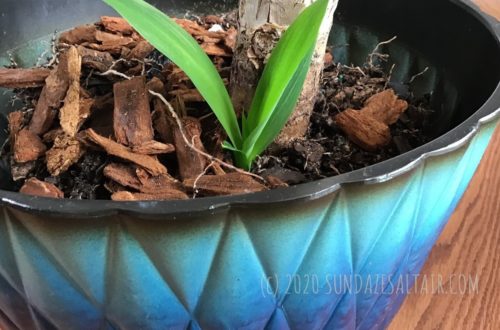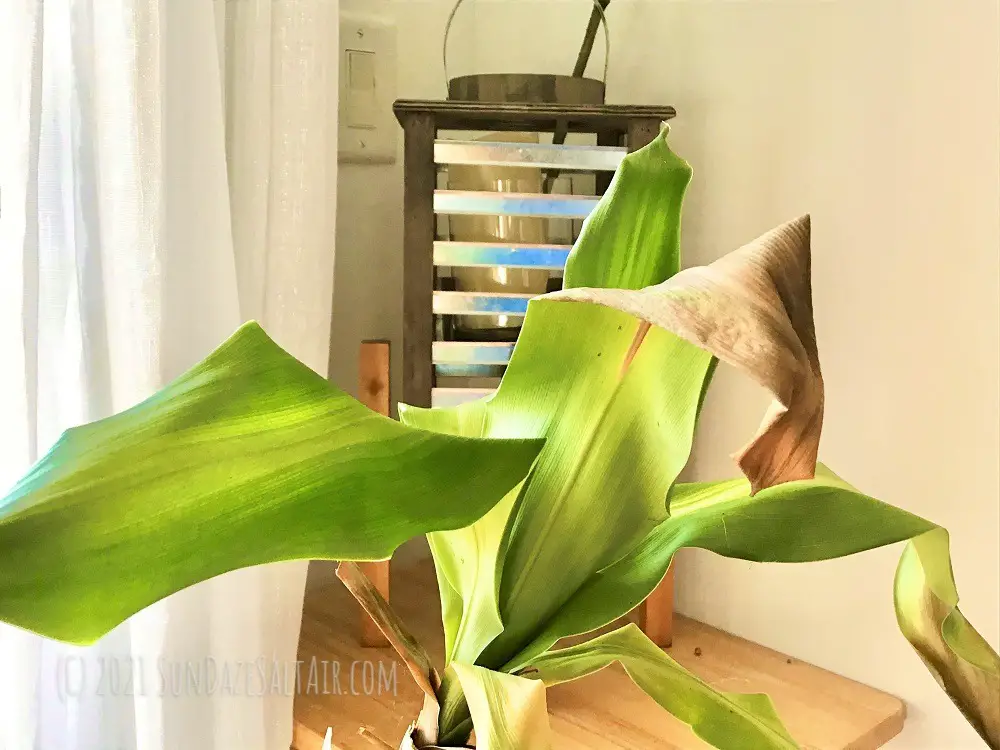
Why Are The Leaf Tips Of My Corn Plant (Dracaena) Brown & Drooping? How To Revive A Drooping Corn Plant
Six Reasons Why Your Corn Plant’s Leaf Tips Are Brown & Droopy & What To Do About It
With a look and shape that recalls a tropical palm tree, the Corn Plant, also known as Dracaena fragrans or a Mass Cane Plant, is a favorite for adding a beachy, island ambiance to any home. The Corn Plant is also known for requiring minimal care and tolerating low light, making it a popular choice for adding greenery to home or office. While its leaves may resemble corn leaves, hence the name, the graceful, airy way they adorn their canes does add a clean, breezy tropical feel to any interior spaces. However, caring for the Corn Plant is not quite as breezy as it appears — with “balance” being the mantra for these plants. When a Corn Plant begins to look more brown and droopy than tropical green and perky, it is telling you that it is not happy, and it is up to you to restore the balance it seeks.
Let’s examine six possible causes of brown, droopy leaf tips (and yellow ones, too) on Corn Plants, plus what you can do to turn those leaves green and healthy again.
Find out how to rescue a drooping Yucca plant here…
Learn how to propagate a new Yucca plant easily from just a side shoot here…
Why Are The Leaf Tips Of Your Corn Plant Brown & Drooping? Six Possible Reasons
The ornamental Corn Plant usually features more than one strong, straight cane, each of differing heights with their tops covered in distinctive light green leaves with a yellowish stripe. Combining tropical good looks with a reputation for being easy to grow in containers, it is little surprise the Corn Plant is a popular indoor plant in both the United States and Europe.
Despite its good reputation, the Corn Plant can be a finicky indoor houseplant which can pose challenges for the home gardener. When it is not happy, the Corn Plant often expresses its dissatisfaction with drooping brown or yellow leaves. Let’s find out what may be ailing your Corn Plant and causing those brown or yellow, drooping leaf tips…

Why Are the Leaf Tips Of Your Corn Plant Brown & Drooping?
Reason #1: Underwatering Your Corn Plant
The Corn Plant, as a native of tropical Africa, enjoys moisture but dreads being stuck in standing water. The challenge at home lies in achieving that happy medium of well-hydrated but not soggy. Well-draining soil and well-draining pots are essential to avoid soggy conditions. As for watering, underwatering or inconsistent watering is the most common mistake to make when caring for indoor plants. As a houseplant living in dry indoor conditions, your Corn Plant depends on you to satisfy its moisture needs. Consequently, neglectful or insufficient watering is the most common cause of your Corn Plant’s brown-tipped leaves.
Be Consistent & Don’t Wait Too Long Between Watering
Unlike your outdoor plants, your indoor Corn Plant needs its hydration from you so aim to keep your Corn Plant’s soil evenly moist. You do not want the plant to dry out too much between watering. If your Corn Plant’s soil is allowed to get too dry for an extended period, browning leaf tips will show up as a side effect.
How Do You Know If Your Corn Plant Needs Water? Perform The “Touch Test”
Before your plant gets dehydrated to the point where its leaf tips turn brown and droopy, look for warning signs of dehydration. One way to do this is to use the “touch test” to feel if the top layer of soil is dry. Even if the surface feels dry, it is advisable that you wait until the soil feels dry two inches down. Soil that is dry two inches down is a clear sign your Corn Plant needs water but also helps minimize the chances of overwatering.
Monitor the soil with this “touch test” about once every four to seven days to prevent dehydration and keep your Corn Plant’s leaf tips from turning brown.
How Much Water Is Enough?
When you water, don’t just “water the surface,” instead water generously. You want to provide enough water to sufficiently quench your plant’s thirst down to the roots. This means that the water should penetrate throughout the pot with any excess draining out drainage holes into the pan or saucer. Check to make sure the drainage holes are not blocked by any rocks or obstructions which can cause water to pool. Pooling water will ultimately rot your plant’s roots and trunk, possibly eventually killing your plant.
Do Reduce Water In Winter
While soil should be kept fairly moist during the growing season, watering should be reduced from fall through late winter as your plant’s growth slows down.
Dry Winter Air Exacerbates Moisture Loss
Heating a home in winter can cause faster moisture loss and painfully dry indoor air. While you will want to slightly reduce the amount of water your Corn Plant gets from fall through late winter due to slower growth, consider boosting humidity around your plant. Replenish the water loss from dry indoor heating with humidity boosting methods mentioned below in Reason #2.
TIP! Did you know Corn Plants are highly sensitive to too much fluoride or boron, both of which are found in fertilizer? Too much of either can burn your plant and turn its leaf tips brown. You may want to skip the fertilizer, but both those compounds are also found in tap water, too… Should you switch to distilled water to water your Corn Plant? Another solution is to leave tap water to sit for a few hours to allow the fluoride to evaporate before watering your plant.
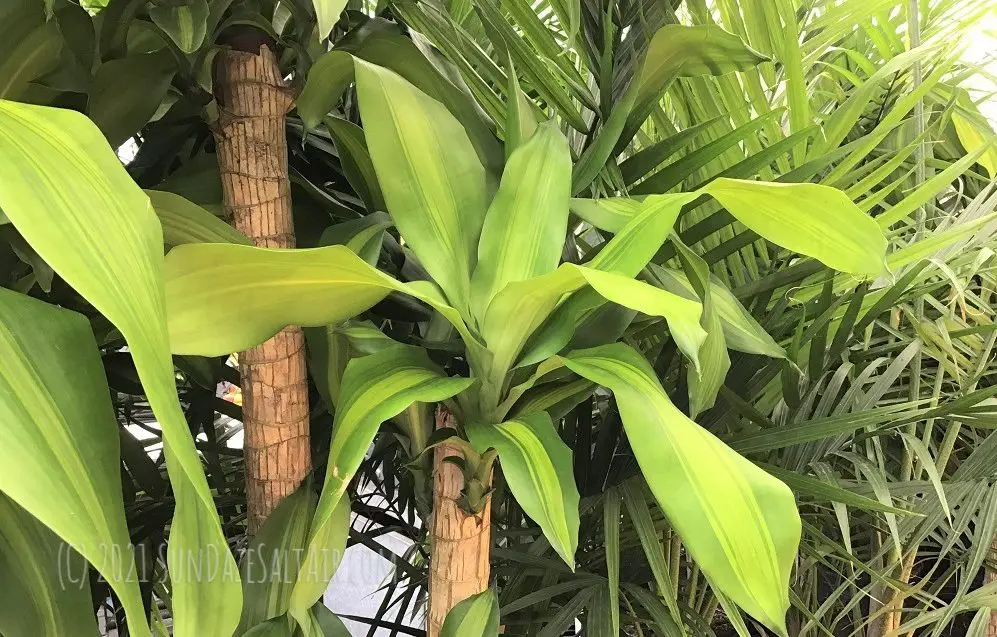
Why Are The Leaf Tips Of Your Corn Plant Brown & Drooping?
Reason #2: Dry Indoor Air & Your Corn Plant
Create Some Humidity
Corn Plants prefer high humidity levels which can be difficult to replicate in most indoor environments. Dry soil plus low humidity, which your Corn Plant is especially prone to in winter in heated indoor air, is a recipe for drooping leaves with brown tips. To provide your Corn plant with some much-needed humidity, boost the water vapor content surrounding your plant with periodic misting from a water spray bottle. Another way to boost humidity in winter is to add a humidifier to the room. You can also create a stone or pebble humidity tray by placing a large dish with stones or pebbles beneath your plant’s container.
Take Advantage Of Fresh, Humid Air When Weather Permits
In the summer, take advantage of the warm, humid weather by placing your potted Corn Plants outdoors temporarily. Keep them sheltered from any strong winds and remember to bring them indoors when temperatures drop into the low 60 degree F range.
Bottomline: Providing higher humidity levels around your Corn Plant may be necessary to combat dry indoor air especially in the long, dry winter season.
TIP! Did you know that if you live in the United States in USDA plant hardiness zones 10 through 12, conditions may be right for you to grow your Corn Plant outdoors? Find out your plant hardiness zone here on this interactive map…
Why Are The Leaf Tips Of Your Corn Plant Brown & Drooping?
Reason #3: Cold Temperatures
Keep Temperatures Moderate To Avoid Browning Leaves
Corn Plants enjoy moderate temperatures around room temperature from about 75 degrees up to 80 degrees F. At night, don’t let temperatures drop too much below 65 degrees F to keep your Corn Plant happy. Beware if the temperature sinks below 50 degrees F, as you your Corn Plant may produce a cold injury in the form of brown leaf edges.
Did You Know? The Corn Plant resembles a palm tree so much that it is often known as a “false palm.”
Why Are The Leaf Tips Of Your Corn Plant Brown (Or Yellow) & Drooping?
Reason #4: Overwatering Your Corn Plant
While a few yellowing leaves are normal for a plant, especially with older leaves, when many leaves display a yellow cast, you may be overwatering. Lots of yellowing leaves in addition to browning leaf tips, means your Corn Plant may be suffering from too much or too frequent watering. Yes, if you forget to water, or if you are overly generous with water, the result is often the same– discolored leaves. Heed this color change as a warning because if this over-zealous watering continues, the end result will usually be a rotted, dying plant.
Aim For Drainage
In addition to following the watering tips mentioned above, aim for well-draining soil and well-draining pots. Drainage is key to help avoid the standing water issue, and any resulting leaf discoloration or rot.
Be Careful With Watering In Winter But Increase Humidity
As stated above, growth slows down significantly in winter but it is tempting to overwater to compensate for dry winter air. While you still need to water, too much water when the plant needs less, will eventually lead to root rot. To avoid this, always use the “touch test” to test for soil dampness two inches down. This allows the soil to dry out slightly and can prevent overwatering your Corn Plant during winter.
At the same time, mitigate the effects of dry heat from artificial heating by increasing humidity with the methods suggested above in Reason #2.
Bottomline: Don’t water if the soil is already damp… Instead of mindlessly watering, remember to test the soil for dampness so your Corn Plant never sits in soggy soil. This issue is made worse if your Corn Plant is receiving inadequate sunlight, which brings us to Reason #5…
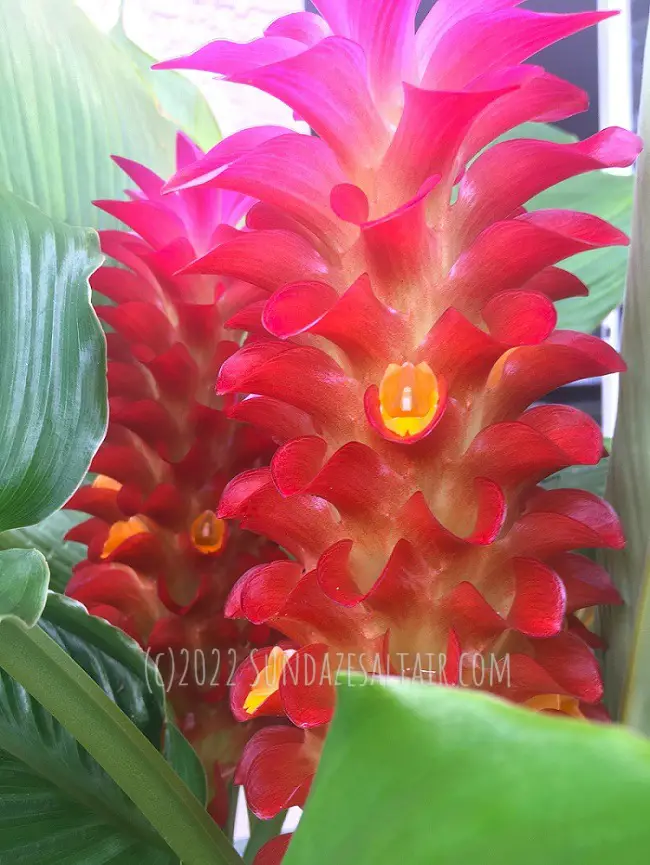
Why Are The Leaf Tips Of Your Corn Plant Brown (Or Yellow) & Drooping?
Reason #5: Insufficient Sunlight (Or Too Much)
While Corn Plants are often touted as being very tolerant of low light conditions, I don’t really find that to be the case, especially over the long-term. Placing Corn Plants in dark rooms with minimal sunlight over time actually causes the Corn Plant to lose its attractive, distinctive striping from its leaves, resulting in one bland solid color. Not only that, eventually a deficiency in sunlight may harm the health of your plant. Insufficient sunlight can stunt the growth of your Corn Plant and also impair its ability to make chlorophyll, contributing to yellowing leaves that may eventually turn brown at the tips.
Try Giving Your Corn Plants More (Filtered) Bright Light
The solution to this is to place your Corn Plants near a window with more abundant, yet filtered sunlight. Placing sheer curtains near the window can further filter the light if the window is especially bright. This prevents the leaves from getting burned, brown and wilted from too much exposure to harsh direct sunlight.
Follow a similar logic when choosing an outdoor location for your Corn Plant for the summer season. Pick a partially shady spot, like a covered lanai or porch, which receives filtered sunlight but not so much that it burns your plant.
Why Are The Leaf Tips Of Your Corn Plant Brown & Drooping?
Reason #6: Pest Infestations Of Your Corn Plant
A stressed Corn Plant, one that is experiencing too much drought or insufficient light, for example, is more prone to pest infestation. If you notice any small creepy crawlies like sap-loving spider mites taking up residence, they may well be further contributing to your Corn Plant’s dehydrated state. Like a vicious cycle, a stressed, underwatered Corn Plant attracts pests like spider-mites. Once they have taken up residence, these sap-loving pests cause further dehydration by draining your plant of needed moisture. The end result is a sickly looking plant with yellowing leaves with brown edges.
Pest Battle Plan
Combat pests such as spider mites or mealybugs as soon as possible before they have a chance to proliferate and take over every inch of your plant. To do this, try spraying your plant with a mild cleaning solution such as dish soap diluted with water. Do this a few times a week to eradicate the bugs without harming your plant. I have also found mild, non-toxic cleaning sprays like Mrs. Meyer’s also do a good job of eliminating the pest problem without damaging my plants.
Conclusion: Follow These Tips Whenever The Leaf Tips Of Your Corn Plant Turn Brown & Drooping
Hopefully, these tips help identify which of the six possible causes are responsible for your Corn Plant’s brown and droopy state. Remember to follow these suggestions anytime you need to restore your Corn Plant’s vitality, and in no time, it should revert to its tropical green and perky self… Also, don’t forget to share this page with your plant-loving friends and bookmark it for future reference.
********
So, how do you keep your Corn Plant looking tropical green & healthy? Share your best tips in the comments…


You May Also Like
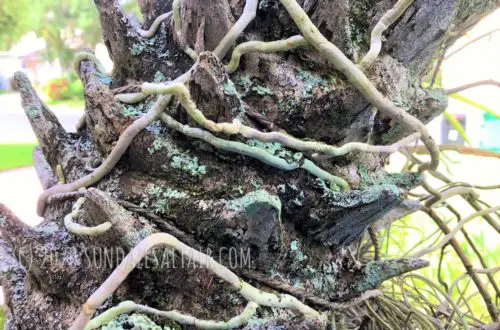
How To Easily Remove An Orchid From A Tree Even If Its Roots Are Well-Attached
August 4, 2021
How & When To Prune A Bougainvillea For Maximum Blooming Potential
July 28, 2021